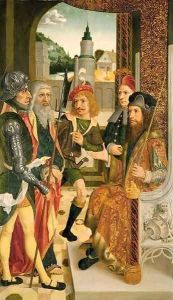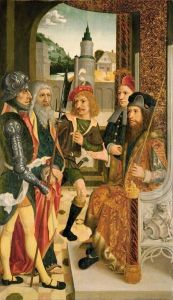Derick Baegert Wasel Paintings
Derick Baegert was a German painter of the late Gothic period, active during the second half of the 15th century and into the early 16th century. He was born around 1440 in Wesel, a city in the northwestern part of Germany, near the Dutch border. Derick belonged to the Baegert family, which included several generations of painters, and he is often considered the most prominent member of this artistic dynasty. His father, Heinrich Baegert, was also a painter, and it is likely that Derick received his initial training in his father's workshop.
Baegert's work is characterized by its attention to detail, vivid color palette, and the influence of Netherlandish painting, which was known for its realism and complex iconography. His figures are typically slender with elongated features, and he often employed a meticulous technique in rendering textiles and surface textures. Derick's oeuvre includes altarpieces, religious panels, and portraits, which were primarily executed in oil on oak panels.
A notable work by Derick Baegert is the 'Dortmund Altarpiece,' completed around 1490, which showcases his skill in creating narrative scenes and his ability to convey the depth of emotion through facial expressions and gestures. This altarpiece was made for the Church of St. Mary in Dortmund and is considered a masterpiece of late Gothic painting in Germany.
While specifics about Baegert's life, including the exact date of his death, are not well-documented, it is known that he was active until at least 1509, as indicated by the dating of some of his known works. His legacy continued through his sons, Jan and Derick Baegert the Younger, who also became painters and contributed to the Baegert workshop's output. Derick Baegert's influence can be seen in the transition from the medieval style of the Gothic period to the more humanistic and naturalistic approaches that characterized the Renaissance era in Northern Europe.

